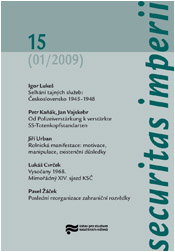Rolnická manifestace: motivace, manipulace, existenční důsledky
The Peasants’ demonstration: motivation, manipulation and personal consequences
Author(s): Jiří UrbanSubject(s): Agriculture, Security and defense, Rural and urban sociology, WW II and following years (1940 - 1949), Post-War period (1950 - 1989), History of Communism
Published by: Ústav pro studium totalitních režimů
Keywords: peasants;Czechoslovakia;Dobruška
Summary/Abstract: That author of this study draws attention to a case of resistance against the communist regime, which occurred in a Czech rural district almost 60 years ago. The work deals with a peasants’ protest rally in front of the District National Committee building in Dobruška. In December 1949, local private farmers decided to respond to official inspections of their homesteads (which forced them to deliver disproportionately large amounts of produce within the framework of the Czechoslovak Communist Party’s agricultural policies) by organising a protest march to the District National Committee. A Czechoslovak national flag was raised at the head of the procession and around 300 people took part in the event. The state security authorities responded with the mass detention of selected farmers, whom it then portrayed as a group of subversives. This resulted in the political trial of 18 farmers, whom communist propaganda disparagingly described as the “village rich” or “kulaks.” The case was heard before the Prague State Court in Hradec Králové. Prison sentences ranging from 13 to 25 years were given to six people who were identified as organisers, while sentences of 1 to 9 years were meted out to the others. Fourteen people had all their property confiscated while five were subsequently forced out of their homes as part of a nationwide security clampdown known as Operation K (“kulaks”). The study describes what motivated the farmers to resist and gives an account of what went on behind the scenes during the investigation. It also outlines how the treasonous group was fabricated and provides details of the hardships suffered by those who were convicted as well as the difficulties subsequently experienced in their district. The paper draws on documents from both central and regional archives.
Journal: Securitas imperii
- Issue Year: 2009
- Issue No: 15
- Page Range: 98-136
- Page Count: 39
- Language: Czech

